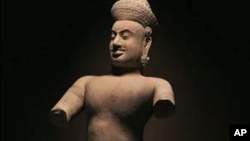A federal judge in New York says that a tenth-century Cambodian statue will remain in the custody of Sotheby’s auction house while a dispute over its proper ownership plays out in court. US District Judge George Daniels said that since all agree that the statue is safely housed in a Sotheby’s warehouse, it should not be subjected to the risk of being moved unnecessarily.
US prosecutors and the Cambodian government say the 1,000-year-old sandstone statue, depicting a warrior in the Hindu saga “The Mahabharata,” was looted from the temple of Prasat Chen in the1960s or 1970s, and should be repatriated. The feet of the statue remain at the temple at Koh Ker, which was briefly the capital of ancient Cambodia.
In a civil complaint, federal prosecutors said that Sotheby’s knew the statue had been stolen when it offered it for auction last year on behalf of a Belgian client who had bought it in 1975, the first time it was publicly sold. The US filing reads like a magazine story, quoting at length from emails exchanged between a Cambodian art expert and Sotheby’s.
“According to the forfeiture complaint, Sotheby’s was told by the very expert they hired to authenticate and appraise the piece, that it was, quote, definitely stolen,” said Tess Davis, an antiquities lawyer who is advising the Cambodian government. “And the same scholar actually urged them to consider donating it back to the national Museum of Phnom Penh to, quote, save everyone some embarrassment.”
In a later email, however, the scholar told Sotheby’s that it did not appear that Cambodia was requesting the return of all looted artifacts owned by foreign individuals and museums, saying “…[I] think that legally and ethically you can happily sell the piece.” Sotheby’s subsequently featured the statue on its catalog cover. It was expected to sell for up to $3 million.
Peter Neiman, an attorney representing Sotheby’s, said the statue was purchased legally by the Belgian collector. “We vigorously dispute the government’s allegations,” he said after the hearing. “Sotheby’s acted in good faith and compliance with the law at all times here, and we expect the evidence is going to show that this is not stolen property, that it belonged to the consignor and Sotheby’s acted perfectly appropriately in consigning it for sale.”
In a statement, Sotheby’s added that the statue may have been missing from its site for as long as a thousand years. It said that “condemning a public sale process inevitably drives those owners of antiquities toward private transactions—an outcome deeply disadvantageous to any and all who claim to be on the side of sensitive and careful handling of this material.”
Davis, however, said that much of Cambodia’s ancient art was looted during the upheaval surrounding Cambodia’s civil war and sold to foreign collectors and museums. “I doubt that anyone who has been working in the field of cultural heritage preservation is very surprised by this court proceeding,” she said.
The statue, known as the Duryodhana, stood facing another warrior figure, the Bhima, whose feet also remain at the Koh Ker temple site. Davis said challenges to the ownership of that figure, now in the collection of the Norton-Simon Museum in California, may also be raised.




